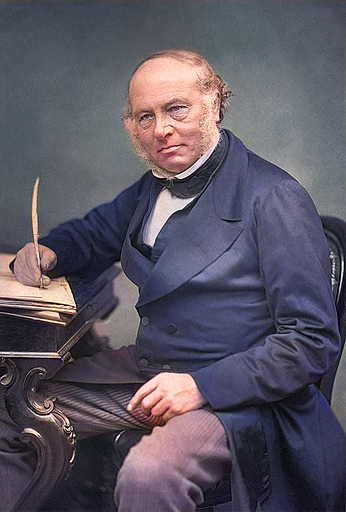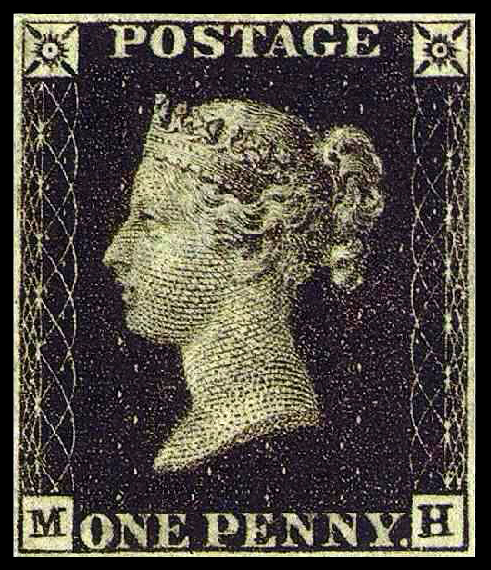
Sir Rowland Hill (1795-1879)
On August 27, 1879, English teacher, inventor and social reformer Sir Rowland Hill passed away. Hill campaigned for a comprehensive reform of the postal system, based on the concept of Uniform Penny Post and his solution of prepayment, facilitating the safe, speedy and cheap transfer of letters. Hill later served as a government postal official, and he is usually credited with originating the basic concepts of the modern postal service, including the invention of the postage stamp.
Rowland Hill – Early Years
Rowland Hill was born in Blackwell Street, Kidderminster, Worcestershire, England, to Thomas Wright Hill, a liberal and forward-thinking social inovator, who founded a school that allowed its pupils to participate in self-governance and instruction.[1] At the age of 12, Rowland became a student-teacher in his father’s school. He taught astronomy and earned extra money fixing scientific instruments. He also worked at the Assay Office in Birmingham and painted landscapes in his spare time.
A Liberal Educator
In 1819 he moved his father’s school “Hill Top” from central Birmingham, establishing the Hazelwood School at Edgbaston, an affluent neighbourhood of Birmingham, as an educational refraction of Joseph Priestley‘s ideas. Hazelwood was aiming for useful, pupil-centred education which would give sufficient knowledge, skills and understanding to allow a student to continue self-education through a life “most useful to society and most happy to himself”. In his Plans for the Government and Liberal Instruction of Boys in Large Numbers Drawn from Experience (1822) Hill argued that kindness, instead of caning, and moral influence, rather than fear, should be the predominant forces in school discipline. Science was to be a compulsory subject, and students were to be self-governing.
Inventions and Australian Colonization
After 1828 Rowland Hill abandoned teaching, experimented with a number of inventions, and in 1832, he published a tract called Home colonies : sketch of a plan for the gradual extinction of pauperism, and for the diminution of crime, then served from 1833 until 1839 as secretary of the South Australian Colonization Commission, which worked successfully to establish a settlement without convicts at what is today Adelaide.
An Interest in Postal Reform
According to folklore, Hill began pondering postal reform after a conversation with a young woman, in tears because a postman had brought a letter from her fiancé but refused to deliver it when she was unable to pay the postage due. Until Rowland’s time, the cost of postage was generally paid by the recipient, and rates were so expensive that mailed correspondence was a luxury beyond the means of ordinary working people. Furthermore, rates were complex, calculated by the distance and the number of pages, among other factors. Envelopes were rarely used, since the envelope counted as a page and added to the cost.[2]
The Idea of an Adhesive Stamp
Rowland Hill first started to take a serious interest in postal reforms in 1835, which led him to the publication, in early 1837, of a pamphlet called Post Office Reform its Importance and Practicability. In the 1830s at least 12½% of all British mail was conveyed under the personal frank of peers, dignitaries and members of parliament, while censorship and political espionage were conducted by postal officials. Fundamentally, the postal system was mismanaged, wasteful, expensive and slow. It had become inadequate for the needs of an expanding commercial and industrial nation. Hill’s report called for “low and uniform rates” according to weight, rather than distance. Hill’s study reported his findings and those of Charles Babbage [5] that most of the costs in the postal system were not for transport, but rather for laborious handling procedures at the origins and the destinations. Costs could be reduced dramatically if postage were prepaid by the sender, the prepayment to be proven by the use of prepaid letter sheets or adhesive stamps. Letter sheets were to be used because envelopes were not yet common; they were not yet mass-produced, and in an era when postage was calculated partly on the basis of the number of sheets of paper used, the same sheet of paper would be folded and serve for both the message and the address. In addition, Hill proposed to lower the postage rate to a penny per half ounce, without regard to distance.

The Penny Black, the World’s first adhesive postage stamp, issued in May 1840
The Penny Black
In the House of Lords the Postmaster, Lord Lichfield, a Whig, denounced Hill’s “wild and visionary schemes.” But merchants, traders and bankers viewed the existing system as corrupt and a restraint of trade. They formed a “Mercantile Committee” to advocate for Hill’s plan and pushed for its adoption. In 1839 Hill was given a two-year contract to run the new system. The Uniform Fourpenny Post rate was introduced that lowered the cost to fourpence from 5 December 1839, then to the penny rate on 10 January 1840, even before stamps or letter sheets could be printed. In May 1840 the World’s first adhesive postage stamps were distributed. With an elegant engraving of the young Queen Victoria (whose 21st birthday was celebrated that month), the Penny Black was an instant success. Refinements, such as perforations to ease the separating of the stamps, were instituted with later issues.
Later Years
When a Tory government took power in 1842 Hill lost his position with Treasury and went to work for a railroad company. When Whigs took power in 1846 he was appointed to an executive post in the Post Office, where he worked for many years. He was knighted Sir Rowland Hill in 1860, and died in 1879.[2]
The Art of the Stamp, Maynard Sundman Lecture 2012, [8]
References and Further Reading:
- [1] Catherine J. Golden, Sir Rowland Hill (1795-1879), at The Victorian Web
- [2] Rowland Hill, at NNDB
- [3] Postal Reforms that Transformed the Mail, The Smithsonian National Post Museum
- [4] The Rarest in the World – The Blue Mauritius, SciHi Blog, September 21, 2013.
- [5] Charles Babbage – The Father of the Computer who hated Street Music, SciHi Blog6
- [6] Rowland Hill at Wikidata
- [7] Penny Black at Wikidata
- [8] The Art of the Stamp, Maynard Sundman Lecture 2012, SmithsonianNPM @ youtube





